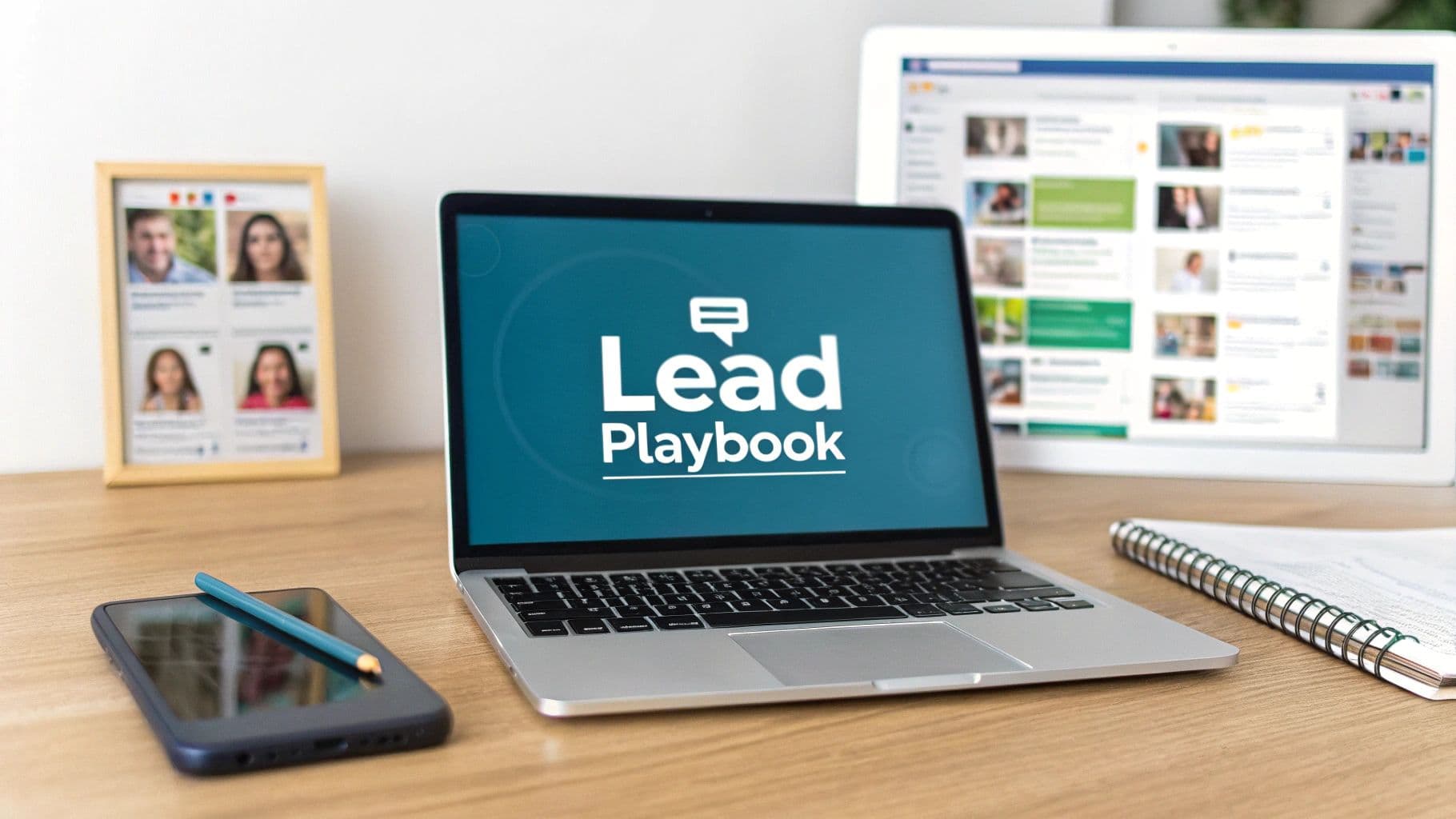
Forget the generic advice. Most social media marketing guides are written by people who've never had to generate a lead to keep the lights on. They talk about vanity metrics and "brand awareness." As a founder, I care about one thing: creating a predictable pipeline.
Here at BillyBuzz, we don't "do social media marketing." We treat platforms like LinkedIn and Reddit as active listening tools. This isn't about broadcasting; it's about intercepting conversations where potential customers are literally asking for help. This is the exact founder-to-founder playbook we use every day.
Stop Broadcasting and Start Connecting
Let's cut the fluff. As a bootstrapped founder, your time is your most valuable asset. The traditional advice—post 3x a day, build a huge following—is a path to burnout with zero ROI. We had to find a better way.
We built a system that treats social media like a dynamic database of prospects who are openly stating their problems. The entire mindset shift is this: stop thinking about what you want to post and start listening to what your ideal customers are already saying.
The Listen, Engage, Convert Framework
Our entire strategy is built on a simple framework we call 'Listen, Engage, Convert.' It’s a disciplined process that turns social platforms from content channels into lead-generation engines. It forces you to shut up and listen.
We’ve broken down our 'Listen, Engage, Convert' framework into three simple phases. Each has a specific goal and a set of actions designed to move a prospect from a passive scroller to an active lead.
| Phase | Core Goal | Primary Actions |
|---|---|---|
| Listen | Identify High-Intent Signals | Set up keyword alerts for pain points. Monitor specific subreddits and competitor comment sections. Find the problems. |
| Engage | Provide Genuine Value First | Answer questions with actionable advice. Share helpful resources (even if they're not yours). Build trust by solving, not selling. |
| Convert | Guide to the Next Step | Once trust is established, move the conversation to DMs or email. Offer a demo as a way to solve their specific problem, not as a sales pitch. |
This system ensures every action is intentional. You're not just "on social media"; you're actively generating opportunities.
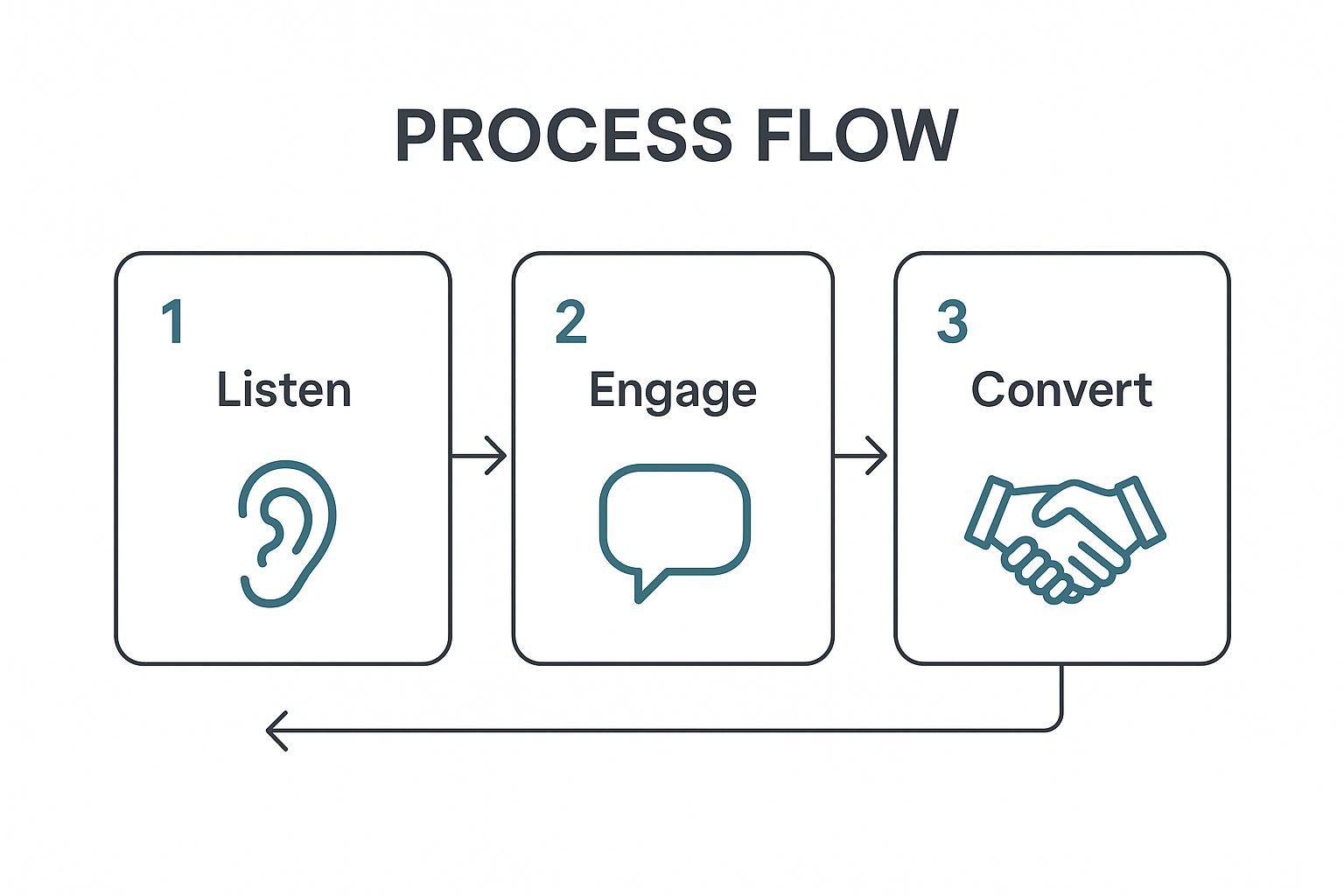
This doesn't have to take all day. Research shows that about 66% of marketers generate leads from social media by spending just six hours per week. That's because a focused, surgical approach is infinitely more powerful than aimless posting.
The biggest mistake I see founders make is using social media as a megaphone. The real unlock is using it as a pair of ears. Find the pain, offer real help, and the leads will come to you.
To make this shift from broadcasting to a results-driven approach, this social media content strategy playbook is a fantastic resource. It's a practical guide that will help you structure your content around meaningful engagement rather than just volume.
When you focus on genuine, helpful interactions, you build trust—the only currency that matters. And if you want to put this on steroids, we also cover how to find leads on social media with AI in another one of our founder-focused guides.
Our LinkedIn Playbook for High-Quality B2B Leads
For B2B founders, LinkedIn is not a social network. It's the most powerful lead gen tool we have, period. We don't spend a dime on ads. Instead, we have a repeatable, non-salesy system that turns LinkedIn into a predictable pipeline.
This isn't about spamming connection requests or pitching in DMs. It's a surgical strategy built on hyper-targeting and genuine conversation. Here's exactly how we do it.
Building Hyper-Targeted Prospect Lists
Garbage in, garbage out. A generic list gets you generic results. That’s why we live inside Sales Navigator. It lets us build razor-sharp lists of people who are showing buying signals.
Here’s a glimpse of the Sales Navigator interface, where we layer different filters to get that pinpoint accuracy.
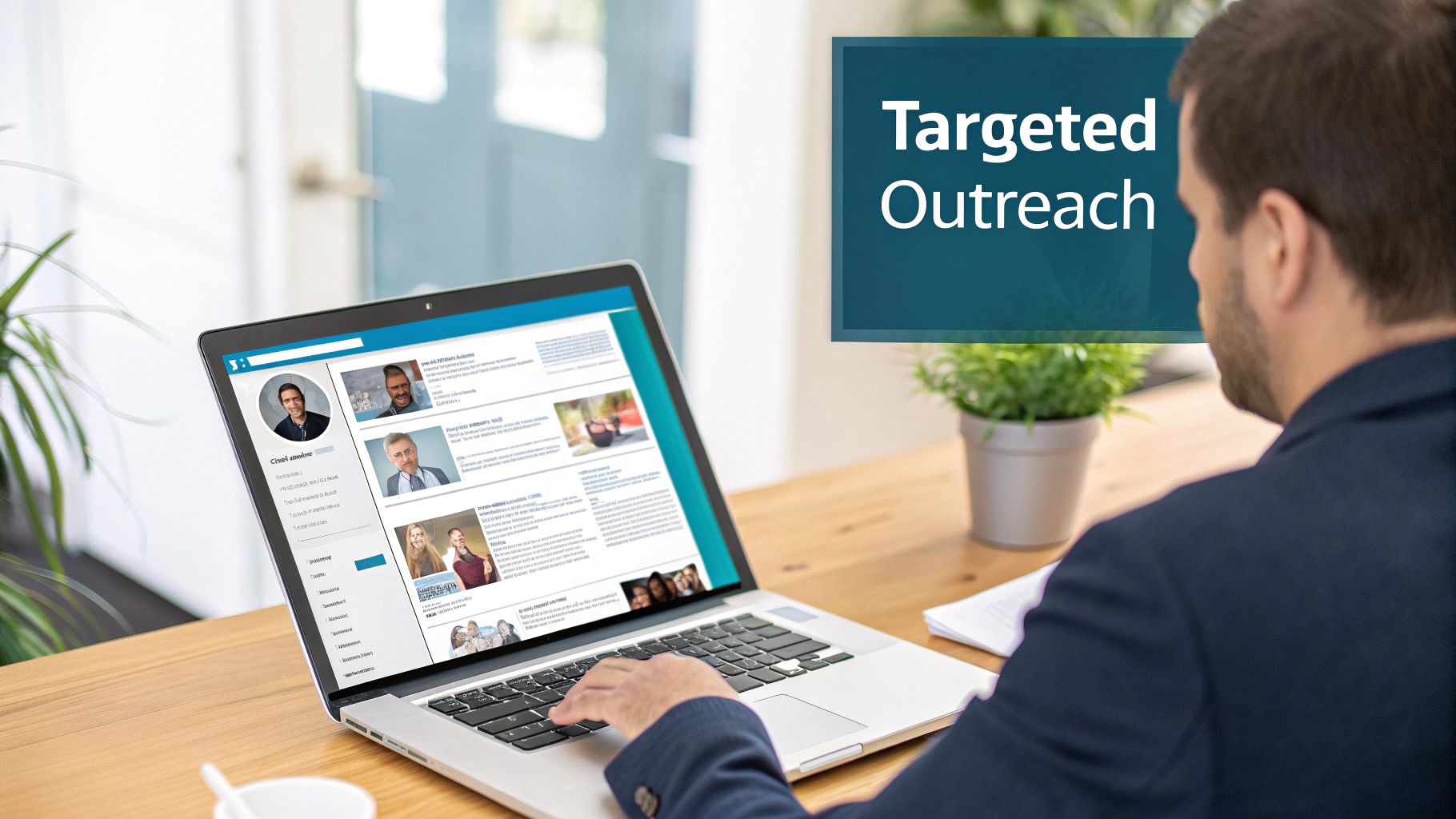
The real magic is combining standard filters with "Spotlights" to find active users.
Here are the exact filters we use inside BillyBuzz:
- Geography: United States
- Industry: Computer Software, Marketing & Advertising, IT Services
- Company Headcount: 11-50, 51-200 (our startup sweet spot)
- Seniority Level: Founder, C-Suite, VP, Director
- Keywords (in profile): "demand generation," "SaaS," "growth marketing"
But here's our secret weapon: we layer on the "Posted on LinkedIn in the last 30 days" Spotlight filter. This single click ensures we only reach out to active users who are far more likely to see and accept our request. It's a game-changer.
The Connection Request That Actually Works
Most connection requests are awful. They're either blank or an immediate pitch. Our goal is just to start a conversation. After endless testing, this simple template consistently gets us a 70%+ acceptance rate.
It's personalized, non-threatening, and gives a reason for connecting.
Our Exact Connection Request Template:
"Hi [First Name], saw you're leading growth at [Company Name]. I'm also in the B2B SaaS space and always looking to connect with other founders/marketers. Would be great to connect."
This works because it's based on a shared context (our industry) and asks for nothing. It’s a low-friction way to get a foot in the door.
From Connection to Conversation
Once they accept, never follow up with a pitch. Our follow-up sequence is designed to offer value and start a real discussion.
It’s a simple two-step process:
- The Thank You & Open-Ended Question: A day after they connect, we send: "Thanks for connecting, [First Name]. Curious, what's been your biggest challenge with [their area of focus, e.g., 'generating qualified leads'] lately?"
- The Value-Add: Based on their answer, we share a relevant resource that can help. This is often a great blog post or a useful tool—and it's never our own product. This is about building trust, not selling.
This approach organically turns a cold connection into a warm conversation. When it's time to talk about what we do, it feels natural.
Content That Pulls Inbound Leads
Outbound is only half the battle. We also post short, tactical content that solves a specific pain point for our ideal customer. We skip the generic "5 Marketing Tips" fluff.
For example, instead of a generic post, we'll write something like, "Tired of missing brand mentions on Reddit? Here's our exact 3-step process for setting up keyword alerts that actually work." This specificity hits home with our audience and positions us as experts.
Finding Hidden Gems in Competitors' Comments
One of our favorite tactics is monitoring the comment sections of our competitors' LinkedIn posts. When someone asks a detailed question or shares a problem, they're raising their hand as a qualified lead.
We jump into those conversations with a helpful, non-promotional perspective. This often leads them to check out our profile, making a connection request feel natural because we've already provided value. It's a goldmine most founders ignore.
The data backs this up. A full 40% of B2B marketers rate LinkedIn as their most effective channel for high-quality leads. And LinkedIn's Lead Gen Forms see an average conversion rate of 13%, blowing the typical 2.35% for landing pages out of the water. If you want to dig deeper, you can find more insights on why LinkedIn is a powerhouse for B2B lead generation. A well-executed organic LinkedIn strategy has one of the highest ROIs a founder can get.
Finding Hidden Leads in Niche Communities
Broadcasting on mainstream platforms feels like shouting into a hurricane. The real gold is in niche communities where our ideal customers are already gathered and actively asking for help.
For us, that means treating places like Reddit as a critical listening post. Forget going viral. We go where the problems are, because that's where you find people with urgent needs. It's a strategy built on helpfulness, not hype.
Pinpointing the Right Conversations
First, you have to find the digital "watering holes" where your prospects hang out. For us, it’s subreddits where founders and marketers are troubleshooting their challenges. We don't just lurk; we become contributing members.
Here's a peek inside r/saas, a community where founders openly discuss tools, strategies, and pain points.
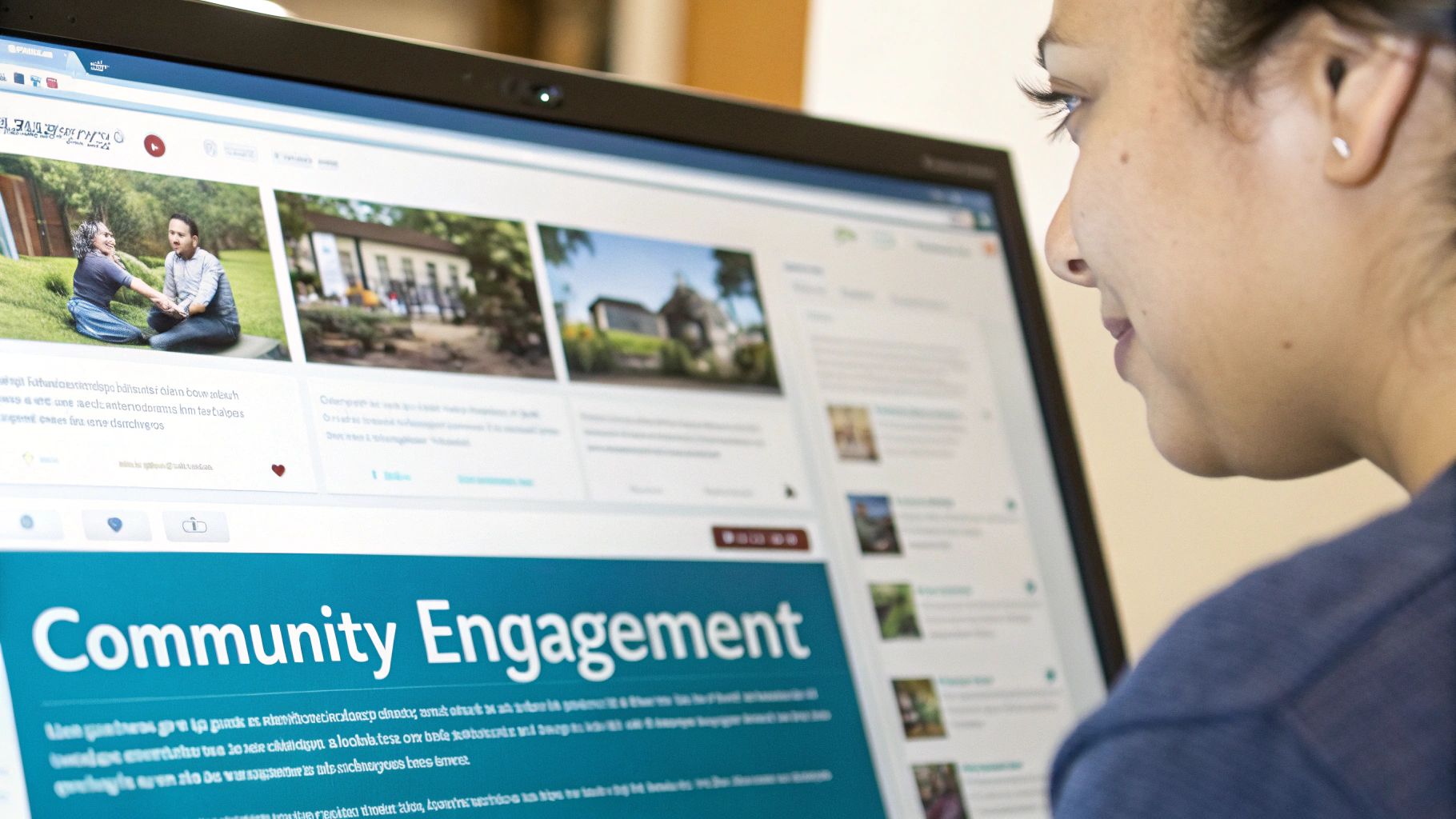
Threads starting with "What's your go-to tool for..." or "How do you handle..." are direct invitations to provide value.
We monitor a core list of subreddits daily, but our approach is automated. We use a tool called F5Bot to set up keyword alerts that notify us the moment a relevant conversation starts. It's our secret weapon for being first on the scene.
Our exact subreddit and keyword alert list:
- Subreddits: r/saas, r/marketing, r/startups, r/smallbusiness
- Keywords: "recommend a tool for," "how do you solve," "alternative to [Competitor Name]," "tracking mentions," "social listening"
These alerts cut through the noise and deliver high-intent conversations directly to our Slack. No more endless scrolling.
The Art of the Helpful, Non-Promotional Comment
Once you find a conversation, the worst thing you can do is drop a link to your product. You'll get downvoted into oblivion. The goal is to be genuinely helpful first.
Here's the response framework we use at BillyBuzz. It adds real value and builds trust.
Our Exact Response Template:
- Acknowledge and Validate: "Great question. Dealing with [problem] is a huge pain."
- Offer a Genuine Solution (without your product): "One thing that worked for us early on was setting up a simple Google Alert. It's free and a good starting point."
- Introduce Your Solution (as context): "We eventually hit the limits of that and ended up building BillyBuzz to solve this for ourselves. It's specifically for monitoring Reddit conversations. Happy to share more if you're curious, but the Google Alert trick might be all you need for now."
This founder-to-founder approach works because it's authentic and low-pressure. It has generated some of our highest-quality leads.
Building Karma and Credibility Is Non-Negotiable
On platforms like Reddit, your history is your resume. A new account dropping links is an instant red flag. You have to put in the work.
This means you have to:
- Participate in unrelated discussions: Share your expertise on other topics.
- Upvote valuable content: Be a good community member.
- Answer questions without self-promotion: Spend weeks just being helpful.
Building karma (Reddit's reputation score) is non-negotiable. You have to earn the right to be heard.
The most powerful lead generation happens when you stop selling and start solving. Your reputation as a helpful expert will attract more customers than any ad campaign ever could.
This strategy takes patience, but the payoff is massive. For a complete walkthrough, our guide on how to get customers from Reddit in 2025 offers an even deeper tactical breakdown. The leads you get from these communities are pre-sold on your expertise because you’ve already helped them.
Using Video to Warm Up Prospects
Text comments get your foot in the door. Video builds a real connection. As a founder, your expertise is your biggest asset, and video is the best way to showcase it. It shortens the sales cycle by turning a stranger into a warm lead in minutes.
I'm not talking about high-budget marketing videos. My entire strategy is built on simple, authentic video. The goal is to be human and helpful in a way text can't replicate.
My Secret Weapon: Short, Impactful Loom Videos
One of the most powerful tactics in our playbook involves creating personalized videos with Loom. When I find a specific question on Reddit or LinkedIn—a problem I know we can solve—I don't just type an answer. I hit record.
I create a quick, two-minute Loom video that is less of a sales pitch and more of a mini-consulting session.
Here's the exact script I follow:
- Call them out by name: "Hey [Username], I saw your question about [their specific problem]. That's a really common hurdle."
- Show, don't tell: I share my screen and walk them through a concept, give a quick demo of a feature, or even point them to another tool that could help.
- Keep it short: Deliver massive value in under three minutes.
Then I drop the Loom link in my reply. It immediately makes me stand out, proves my expertise, and gives huge value with zero strings attached. It builds instant trust.
The moment you switch from telling someone how you can help to showing them, the entire dynamic of the conversation changes. A personal video turns you from a random commenter into a trusted advisor.
Nurturing Leads at Scale with Live Sessions
While one-on-one videos are for surgical strikes, I use live video to engage dozens of prospects at once. Once a month, I'll host a live Q&A or a quick product demo on LinkedIn Live, promoting it for a week in the communities where I'm active.
These sessions are intentionally casual. It's not a stuffy webinar; it's a real conversation where other founders can ask the "stupid" questions they might be too intimidated to ask elsewhere.
My live sessions follow this flow:
- Kick off with a specific problem: I start by tackling a common pain point I've seen that week.
- Encourage questions from the start: The session is for them, driven by their questions, not my script.
- Follow up personally: I take notes on who attended and what they asked, allowing for a relevant, personal follow-up message.
This strategy is incredibly efficient. A single 30-minute session lets me educate and build relationships with a whole group of potential leads at scale.
This combination of social selling and video is a massive force. Around 78% of consumers say they'd rather learn about a product from a short video. You can discover more insights about these 2025 lead generation trends to see just how central video is becoming. By leaning into this, you're meeting prospects where they are, in a format they love.
Turning Engagement into Demos with Smart Automation
Manual outreach is a path to burnout. I've been there. As a founder, you can't waste time copying and pasting prospect details from social media into a CRM. This is where smart automation comes in—and I'm not talking about spammy bots.
The goal isn't to automate the conversation. That must be you. The magic is automating everything around the conversation. This frees you up to build real relationships. We built a simple system that pipes social listening signals directly into our sales pipeline, ensuring no lead goes cold.
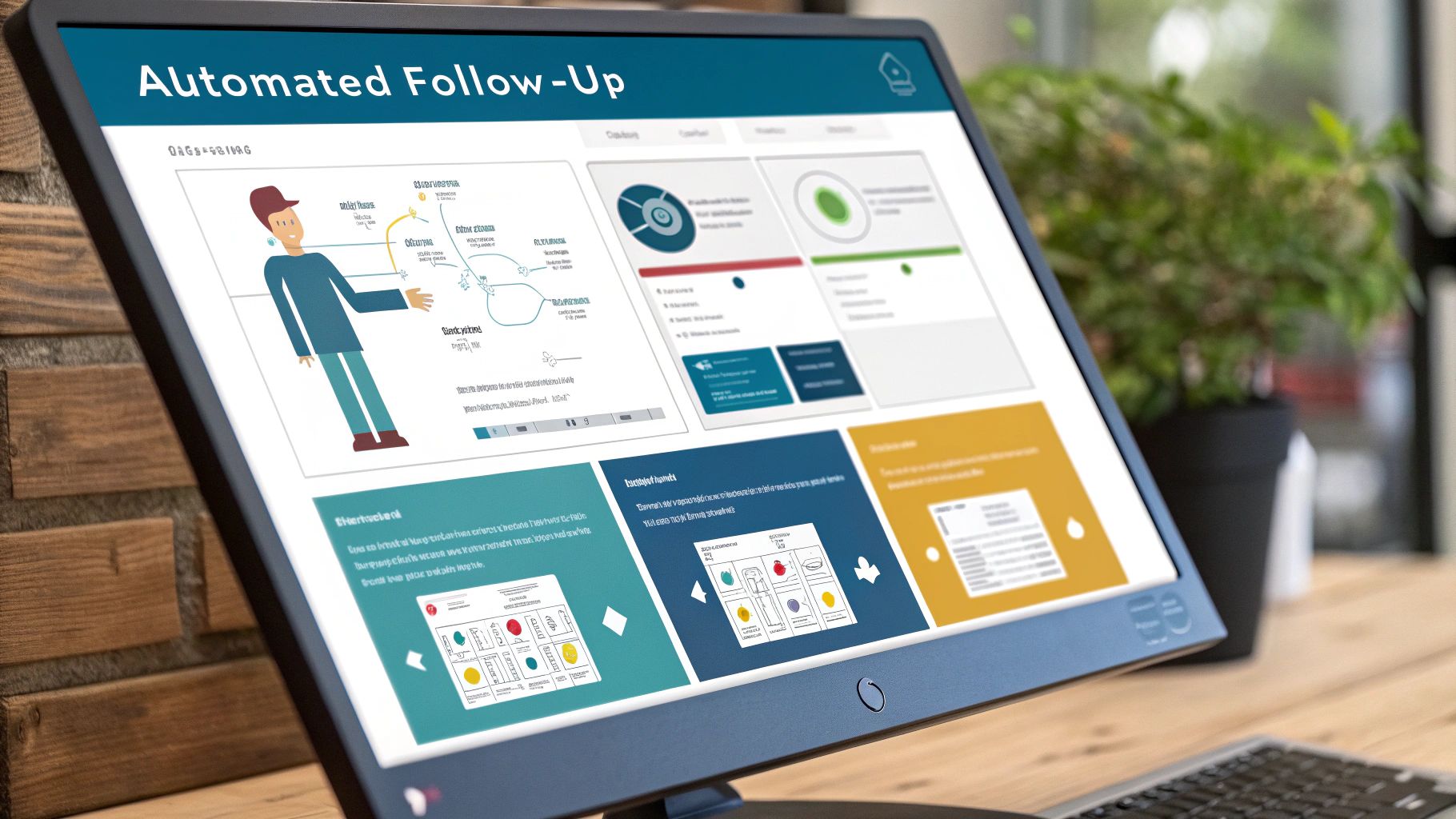
Our Internal Automation Stack
The glue holding our system together is Zapier. We use it to create simple "if this, then that" workflows that handle the admin work, turning a social comment into an actionable task.
Here is our most powerful Zap, step-by-step:
- Trigger: Our social listening tool (BillyBuzz) flags a high-intent keyword on Reddit.
- Filter: The Zap only continues if the post has more than 2 upvotes (a small quality filter).
- Action 1: Zapier creates a new Deal in our HubSpot CRM in the "New Lead" pipeline stage.
- Action 2: It then creates a Task in HubSpot assigned to me, with the deal name "Respond to [Username] on Reddit" and the post URL in the notes.
This entire workflow takes seconds. It means I don't hunt for opportunities—I just open HubSpot and see a prioritized list of warm conversations waiting for a personal touch. This automation saves us at least five to ten hours of manual work every week.
We don't automate outreach; we automate opportunity management. This keeps our engagement human while making sure our follow-up is systematic and reliable.
Having a system like this is critical. All the effort of finding prospects is wasted without a reliable process to follow up.
Moving the Conversation Off-Platform
Social media DMs are great for breaking the ice, but they're a terrible place for a serious business conversation. The trick is knowing when and how to move to email or a call.
We use a simple framework to know when it's time to make the switch:
- The 3-Reply Rule: If a DM conversation goes back and forth more than three times each, they're interested.
- Problem-Solving Language: When they start describing their specific problems, it's time.
- Direct Buying Signals: If they ask about pricing or features, move it immediately.
Once a trigger is hit, we use our "permission-based" transition script. It's low-pressure and helpful.
Our Go-To Transition Script:
"This is a great question, and I think the answer might be too detailed for a DM. Would you be open to me sending a quick email with more info, or even hopping on a 15-min call to walk through it? No pressure at all, just want to make sure I give you the best answer."
This script just works. By putting them in control, it feels less like a sale and more like help. It has a ridiculously high success rate for booking demos because it frames the next step as a benefit for them.
This approach marries efficiency with a human touch. To see how this scales, it’s worth understanding how chatbots drive deals and revenue when used correctly. Similarly, our guide on personalized outreach with AI segmentation dives deeper into how tech can help you scale these personal interactions without losing what makes them special.
Your Questions Answered
As founders, we're always talking to other entrepreneurs trying to crack this code. It’s not magic; it’s a repeatable process. Here are straight answers to the questions we get asked constantly.
How Much Time Should I Actually Spend on Social Media for Leads?
The answer isn't "as much as possible"—it's about focused effort. At BillyBuzz, I block out 45-60 minutes per day specifically for this. Anything more is just doomscrolling.
The key is to have a system. I don't just log in and browse. My keyword alerts and Sales Navigator lists are already running. My time is spent on high-value actions—responding to conversations, not hunting for them. Consistency beats volume every time.
What Is the Best Platform for Generating Leads?
It depends entirely on your business. For our B2B SaaS, the breakdown is clear:
- LinkedIn: Our #1 channel for targeted outbound and professional credibility. It’s where we find the exact decision-makers we need.
- Reddit: Our #1 channel for inbound leads. This is where people anonymously describe their problems, creating the warmest possible opening.
- X (formerly Twitter): Good for real-time conversations, but it's a lot of noise. We use it sparingly.
Don’t try to be everywhere at once. Get really good at one channel where you know your customers are talking, and then think about expanding. If you're B2B, start with LinkedIn. If you're B2C or have a community-focused product, Reddit can be a goldmine.
Trying to master five platforms is a recipe for burnout. Pick one, build a process, and only add another when the first is a reliable lead source.
How Do I Measure the ROI of My Efforts?
Forget vanity metrics like likes and followers. They don't pay the bills. We only track metrics that directly impact revenue.
Our essential social lead gen metrics:
- Conversations Started: How many real, back-and-forth interactions did we have this week?
- Demos Booked from Social: How many of those chats led directly to a booked demo? This is our North Star.
- Lead-to-Close Rate by Channel: We track which platform—LinkedIn or Reddit—sends leads that actually become customers.
Everything else is noise. We use a simple UTM parameter (e.g., ?utm_source=reddit_comment_saas) on any link we share. This gives us hard data in our analytics to double down on what works and cut what doesn't.
Ready to stop scrolling and start converting? BillyBuzz is the AI-powered tool we built to automate our Reddit monitoring. It finds high-intent conversations and sends them straight to you, so you can focus on building relationships that turn into revenue. Discover your first hidden leads today at https://www.billybuzz.com.
